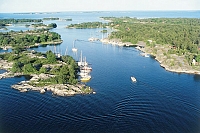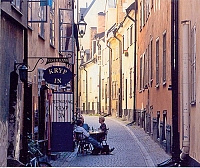Information about Sweden
Sweden
The warm Gulf Stream in the Atlantic gives Sweden a milder climate than other areas equally as far north. Stockholm has an average temperature of about 17°C (63°F) in July. The winter temperatures average slightly below freezing and snowfall is moderate. The most northerly parts of Sweden have long and cold winters and bright summers of moder-ate temperatures; in June and July daylight lasts around the clock.
Geography
Sweden has an area of 450,000 km² (174,000 sq. Mi.). Half its land surface is covered with forest. Less than 10% is farmland. Nearly 100,000 lakes dot the countryside, which is rela-tively flat. A long mountain chain in the Northwest reaches heights of up to 2,111 m (6,926 ft). There are thousands of islands along the jagged coast.
People
Sweden has a population of 8.9 million, with about 85% living in the southern half of the country. Swedish is a Nordic Germanic language.
Parliamentary democracy
Sweden is a constitutional monarchy with a parliamentary form of government. Today the King, Carl XVI Gustaf, has only ceremonial functions as Head of State. The Parliament consists of one chamber, whose members are directly elected by proportional representa-tion for four- year terms. Sweden has universal suffrage and the voting age is 18. Voter turnout is traditionally very high, 80–90%.
Foreign policy and defence
Sweden is an active participant in international co-operation. Strong support for the Euro-pean Union and United Nations is one cornerstone of its foreign policy. The country is also a member of many other international organizations such as the OECD and the World Bank. There is far-reaching co-operation between the Nordic countries in social welfare, cultural affairs and a joint labour market.
Industry and economy
At the beginning of this century Sweden was largely an agrarian economy, and one of the poorest nations in Europe. However, a rich domestic supply of iron ore, timber and water-power, clever engineers and skilled workers enabled a rapid industrialization that trans-formed Sweden into a modern welfare state.
Traditionally, scale-intensive industries (e.g. pulp, paper and paper
products and ferrous metal products) have had a large share of Swedish
exports. However, Sweden is also a rela-tively important exporter of
more technically sophisticated products like telecommunica-tions
equipment, specialized machinery and motor vehicles. Science-based
products (e.g. pharmaceuticals) account for around 10% of manufacturing
value added.
The international recession in 1989-91 forced companies to review their
operations to eliminate inefficiency and unnecessary costs in order to
improve productivity, thereby in-creasing manufacturing productivity by
8% during 1991. The competitive edge of Swedish industry was further
sharpened by the depreciation of the exchange rate in 1992. As a re-sult
the growth in exports exceeded market growth in 1993-95 and Sweden’s
market shares increased by more than 20%.
Since 1992, when the Swedish krona was floated and fell in value by about one fourth, the government has made great efforts to restore balance. Therefore, the conditions for growth, as far as the macroeconomic situation is concerned, presently seem bright. Infla-tion is very low and long-term interest rates have declined considerably.
Sweden and surveyors
Surveyors are employed in most organisations in Sweden and are the co-ordinators in all fields of development in the Swedish society. Many banks, estate companies, building firms, valuation consultants and others employ surveyors as key persons. The Swedish communes are together a very big employer. The biggest employer is the Swedish Land survey and reflects the history of surveying in Sweden for more than 375 years.
![]() Lantmäteriet – the National Land Survey of Sweden
Lantmäteriet – the National Land Survey of Sweden
Lantmäteriet – the National Land Survey of Sweden – celebrated its 375 years anniversary in 2003. The organisation was established as a state agency when the King Gustav II Adolf on 4 April 1628 appointed the mathematician and cartographer Anders Bure as the first head of the organisation. His task was to set up the organisation and to employ and educate the staff with the aim to create a systematic surveying and mapping of the entire country.
The first years focus was set on mapping at larger scales (over villages, homesteads, and cities). After that an intensive period of mapping at smaller scales followed. During this period, which lasted until the beginning of the 1800’s century topographic maps and land-use maps over counties, parishes, road networks, and lakes and rivers was produced. From the middle of the 1800’s century extensive land reforms took place in Sweden, which also meant that the land surveyors to a high degree were engaged in this work.
However, the systematic mapping continued and the results from the mapping activities are uniquely well preserved and documented in archives containing several hundred thousand maps and documents. Today, parts of this material can directly be accessed on the Internet and Lantmäteriet is rapidly making more and more of this information available in digital form.
Sweden also has the advantage of a long tradition of cadastral mapping and parcel-based records developed for taxation and land consolidation. The computerisation of the real property and land registry, which started 1968 and now for long time have been in opera-tion, has contributed to a very efficient land administration based on electronic titles and mortgages and made the use of land information as a base for a broad range of activities in society very effective.
Lantmäteriet’s overall goal today is to support the creation of an efficient and sustainable use of land and water. The organisation has three divisions: Cadastral services, Land and Geographic Information Services and Metria. These divisions are supported by Corporate functions. Swedesurvey AB, a limited company, is the international agency of the organi-sa¬tion.
The total staff is approximately 2,100. The headquarters is situated in Gävle. Lantmäteriet has in total around 100 offices throughout the country. The annual turnover is approxi-mately 1,500 million SEK (160 million Euro) of which 70 percent is generated through charging fees on real property formation, the use of information from databases and on consultancy services. Core grants from the Government is primarily used for producing basic geographic data and managing and maintaining registers and databases.
The activities of Lantmäteriet comprises the following main product areas:
- Cadastral procedures
- Cadastral consulting
- Property information
- Credit Market System
- Printed maps and CD products
- Geographic Sweden Data
- Historical maps
- Geodesy and field survey
- Satellite imagery, remote sensing and visualisation services
- Surveying and large-scale mapping
- GIS consultancy services, software and training
- Customised databases and maps
- Atlases and tourist maps
Lantmäteriet is today very active in the international field. The activities comprise active par-ticipation in standardisation and harmonisation with the aim to facilitate exchange of geo-graphic information and property information. More and more of research and development projects are also carried out in co-operation with international partners. Lantmäteriet is furthermore very active in supporting developing countries, for example through UN/ECE Working Party on Land Administration. The Swedish surveyors have also contributed to the devel-opment of the surveying international society, among others through an active participation in FIG.
Natural resources
Sweden has rich natural supplies of coniferous forest, hydropower, iron ore, and uranium and other minerals but lacks significant oil and coal deposits. The iron ore mines are situ-ated in the far north. Their production is mainly exported.
Environmental concern
The Swedish Government’s overall environmental policy objective is to solve Sweden’s major environmental problems within a generation, i.e. 25 years. The City of Stockholm is making several major investments in environment, such as for example investing in envi-ronmentally friendly vehicles.
Source: The Swedish Institute.

